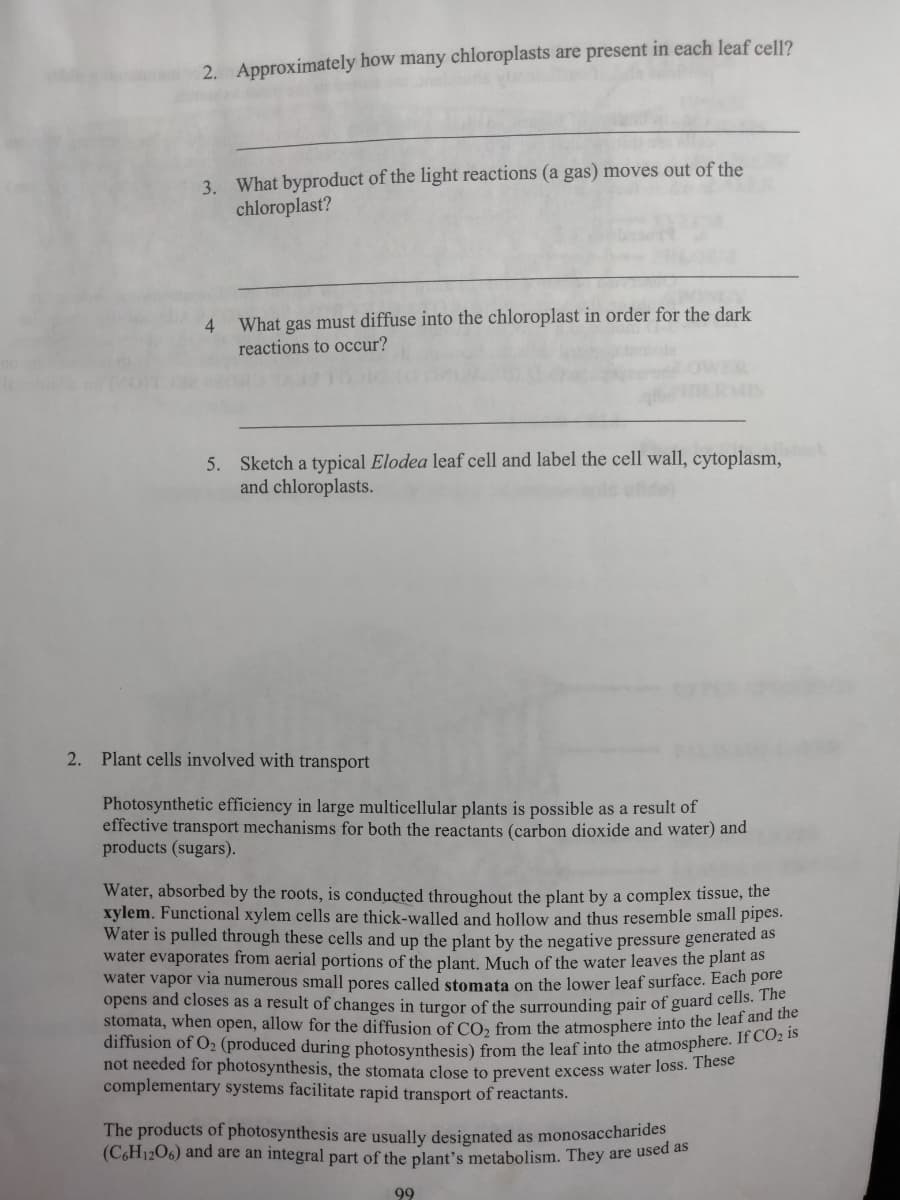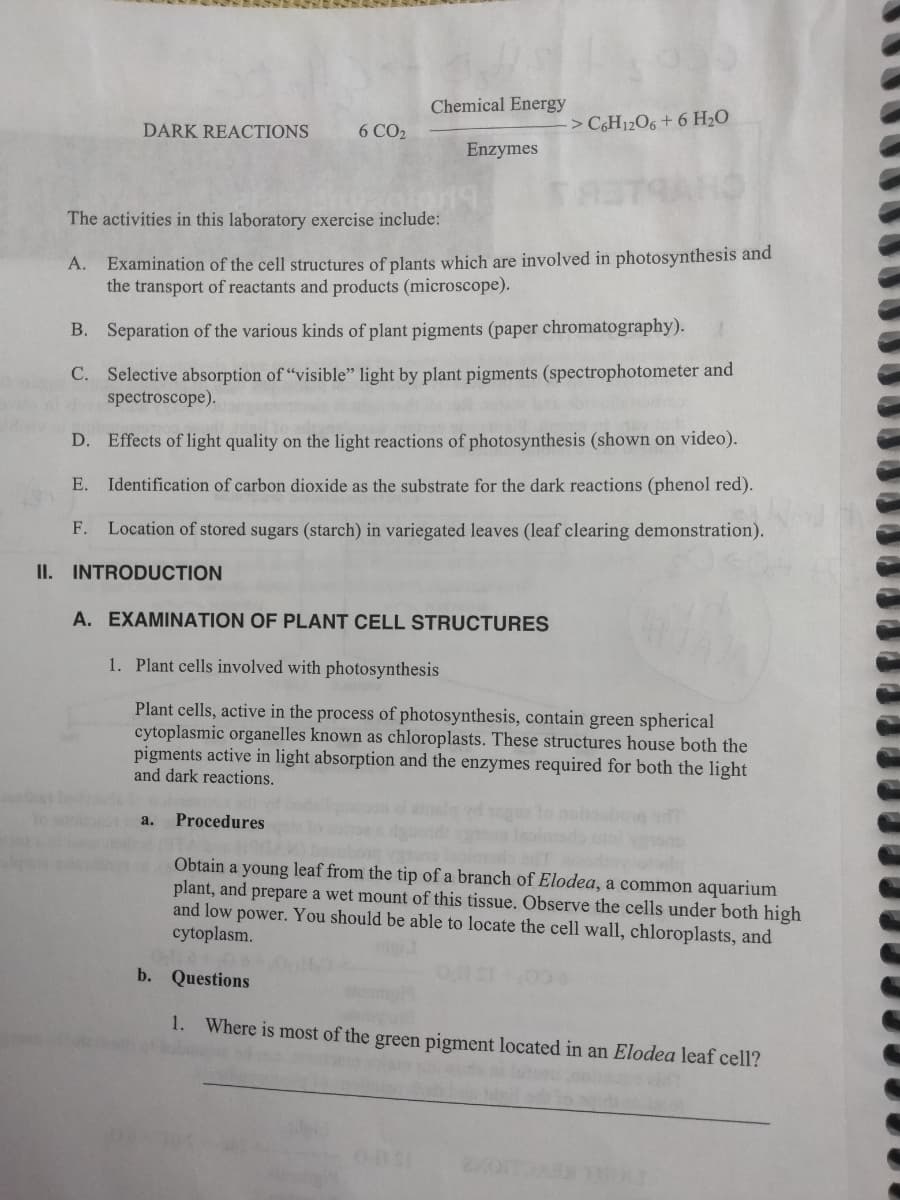2. Approximately how many chloroplasts are present in each leaf cell? 3. What byproduct of the light reactions (a gas) moves out of the chloroplast? 4 What gas must diffuse into the chloroplast in order for the dark reactions to occur?
2. Approximately how many chloroplasts are present in each leaf cell? 3. What byproduct of the light reactions (a gas) moves out of the chloroplast? 4 What gas must diffuse into the chloroplast in order for the dark reactions to occur?
Biochemistry
6th Edition
ISBN:9781305577206
Author:Reginald H. Garrett, Charles M. Grisham
Publisher:Reginald H. Garrett, Charles M. Grisham
Chapter21: Photosynthesis
Section: Chapter Questions
Problem 5P: The Relative Efficiency of ATP Synthesis in Noncyclic versus Cyclic Photophosphorylation If...
Related questions
Question

Transcribed Image Text:2. Approximately how many chloroplasts are present in each leaf cell?
3. What byproduct of the light reactions (a gas) moves out of the
chloroplast?
4
5.
What gas must diffuse into the chloroplast in order for the dark
reactions to occur?
a typical Elodea leaf cell and label the cell wall, cytoplasm,
and chloroplasts.
2. Plant cells involved with transport
Photosynthetic efficiency in large multicellular plants is possible as a result of
effective transport mechanisms for both the reactants (carbon dioxide and water) and
products (sugars).
Water, absorbed by the roots, is conducted throughout the plant by a complex tissue, the
xylem. Functional xylem cells are thick-walled and hollow and thus resemble small pipes.
Water is pulled through these cells and up the plant by the negative pressure generated as
water evaporates from aerial portions of the plant. Much of the water leaves the plant as
water vapor via numerous small pores called stomata on the lower leaf surface. Each pore
opens and closes as a result of changes in turgor of the surrounding pair of guard cells. The
stomata, when open, allow for the diffusion of CO₂ from the atmosphere into the leaf and the
diffusion of O₂ (produced during photosynthesis) from the leaf into the atmosphere. If CO₂ is
not needed for photosynthesis, the stomata close to prevent excess water loss. These
complementary systems facilitate rapid transport of reactants.
The products of photosynthesis are usually designated as monosaccharides
(C6H1206) and are an integral part of the plant's metabolism. They are used as
99

Transcribed Image Text:DARK REACTIONS
6 CO₂
Chemical Energy
Enzymes
a. Procedures
-> C6H12O6 + 6 H₂O
The activities in this laboratory exercise include:
A. Examination of the cell structures of plants which are involved in photosynthesis and
the transport of reactants and products (microscope).
B. Separation of the various kinds of plant pigments (paper chromatography).
C. Selective absorption of "visible" light by plant pigments (spectrophotometer and
spectroscope).
D.
Effects of light quality on the light reactions of photosynthesis (shown on video).
E.
Identification of carbon dioxide as the substrate for the dark reactions (phenol red).
F. Location of stored sugars (starch) in variegated leaves (leaf clearing demonstration).
II. INTRODUCTION
A. EXAMINATION OF PLANT CELL STRUCTURES
1. Plant cells involved with photosynthesis
Plant cells, active in the process of photosynthesis, contain green spherical
cytoplasmic organelles known as chloroplasts. These structures house both the
pigments active in light absorption and the enzymes required for both the light
and dark reactions.
Obtain a young leaf from the tip of a branch of Elodea, a common aquarium
plant, and prepare a wet mount of this tissue. Observe the cells under both high
and low power. You should be able to locate the cell wall, chloroplasts, and
cytoplasm.
b. Questions
1. Where is most of the green pigment located in an Elodea leaf cell?
Expert Solution
This question has been solved!
Explore an expertly crafted, step-by-step solution for a thorough understanding of key concepts.
This is a popular solution!
Trending now
This is a popular solution!
Step by step
Solved in 2 steps with 2 images

Knowledge Booster
Learn more about
Need a deep-dive on the concept behind this application? Look no further. Learn more about this topic, biology and related others by exploring similar questions and additional content below.Recommended textbooks for you

Biochemistry
Biochemistry
ISBN:
9781305577206
Author:
Reginald H. Garrett, Charles M. Grisham
Publisher:
Cengage Learning

Biology 2e
Biology
ISBN:
9781947172517
Author:
Matthew Douglas, Jung Choi, Mary Ann Clark
Publisher:
OpenStax

Biology: The Dynamic Science (MindTap Course List)
Biology
ISBN:
9781305389892
Author:
Peter J. Russell, Paul E. Hertz, Beverly McMillan
Publisher:
Cengage Learning

Biochemistry
Biochemistry
ISBN:
9781305577206
Author:
Reginald H. Garrett, Charles M. Grisham
Publisher:
Cengage Learning

Biology 2e
Biology
ISBN:
9781947172517
Author:
Matthew Douglas, Jung Choi, Mary Ann Clark
Publisher:
OpenStax

Biology: The Dynamic Science (MindTap Course List)
Biology
ISBN:
9781305389892
Author:
Peter J. Russell, Paul E. Hertz, Beverly McMillan
Publisher:
Cengage Learning

Biology (MindTap Course List)
Biology
ISBN:
9781337392938
Author:
Eldra Solomon, Charles Martin, Diana W. Martin, Linda R. Berg
Publisher:
Cengage Learning

Anatomy & Physiology
Biology
ISBN:
9781938168130
Author:
Kelly A. Young, James A. Wise, Peter DeSaix, Dean H. Kruse, Brandon Poe, Eddie Johnson, Jody E. Johnson, Oksana Korol, J. Gordon Betts, Mark Womble
Publisher:
OpenStax College